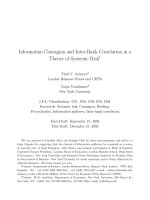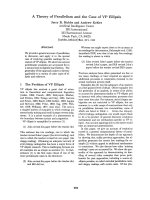Crime and culpability a theory of criminal law
Bạn đang xem bản rút gọn của tài liệu. Xem và tải ngay bản đầy đủ của tài liệu tại đây (2.51 MB, 374 trang )
This page intentionally left blank
Crime and Culpability
A Theory of Criminal Law
This book presents a comprehensive overview of what the criminal law would
look like if organized around the principle that those who deserve punishment
should receive punishment commensurate with, but no greater than, that which
they deserve. Larry Alexander and Kimberly Kessler Ferzan argue that desert
is a function of the actor’s culpability and that culpability is a function of the
risks of harm to protected interests that the actor believes he is imposing and
his reasons for acting in the face of those risks. The authors deny that resultant
harms, as well as unperceived risks, affect the actor’s desert. They thus reject
punishment for inadvertent negligence as well as for intentions or preparatory
acts that are not risky. Alexander and Ferzan discuss the reasons for imposing
risks that negate or mitigate culpability, the individuation of crimes, and omissions. They conclude with a discussion of rules versus standards in criminal
law and offer a description of the shape of criminal law in the event that the
authors’ conceptualization is put into practice.
Larry Alexander is the Warren Distinguished Professor of Law at the University
of San Diego. He has authored and coauthored, in addition to several anthologies and 170 articles, essays, and book chapters, five books, most recently Is
There a Right to Freedom of Expression? and, with Emily Sherwin, Demystifying
Legal Reasoning. He is also past president of AMINTAPHIL, a founding
coeditor of the journal Legal Theory, and codirector of the Institute for Law and
Philosophy at the University of San Diego.
Kimberly Kessler Ferzan is Associate Dean for Academic Affairs and Professor
of Law at Rutgers University School of Law, Camden, and is Associate Graduate
Faculty in the Philosophy Department, Rutgers University, New Brunswick.
The author of numerous articles, essays, and book chapters on criminal law
theory, she is cofounder and codirector of the Rutgers-Camden Institute for
Law and Philosophy.
Cambridge Introductions to Philosophy and Law
Editors
William A. Edmundson, Georgia State University
Brian Bix, University of Minnesota
This introductory series of books provides concise studies of the philosophical
foundations of law, of perennial topics in the philosophy of law, and of important
and opposing schools of thought. The series is aimed principally at students in
philosophy, law, and political science.
Other Books in the Series
An Introduction to Rights, by William A. Edmundson
Objectivity and the Rule of Law, by Matthew H. Kramer
Demystifying Legal Reasoning, by Larry Alexander and Emily Sherwin
Crime and Culpability
A Theory of Criminal Law
LARRY ALEXANDER
University of San Diego School of Law
KIMBERLY KESSLER FERZAN
Rutgers University School of Law, Camden
With contributions by
STEPHEN J. MORSE
University of Pennsylvania Law School
CAMBRIDGE UNIVERSITY PRESS
Cambridge, New York, Melbourne, Madrid, Cape Town, Singapore, São Paulo
Cambridge University Press
The Edinburgh Building, Cambridge CB2 8RU, UK
Published in the United States of America by Cambridge University Press, New York
www.cambridge.org
Information on this title: www.cambridge.org/9780521518772
© Larry Alexander and Kimberly Kessler Ferzan 2009
This publication is in copyright. Subject to statutory exception and to the
provision of relevant collective licensing agreements, no reproduction of any part
may take place without the written permission of Cambridge University Press.
First published in print format 2009
ISBN-13
978-0-511-50709-0
eBook (EBL)
ISBN-13
978-0-521-51877-2
hardback
ISBN-13
978-0-521-73961-0
paperback
Cambridge University Press has no responsibility for the persistence or accuracy
of urls for external or third-party internet websites referred to in this publication,
and does not guarantee that any content on such websites is, or will remain,
accurate or appropriate.
For Elaine, the best criminal lawyer I know,
L. A.
For Griffin,
K. K. F.
Contents
Acknowledgments
page xiii
Introduction: Retributivism and
the Criminal Law
PA RT ON E
1 Criminal Law, Punishment, and Desert
I The Criminal Law and Preventing Harm
II Questions about Retributivism
III Conclusion
PA RT T WO
4
7
17
The Culpable Choice
2 The Essence of Culpability: Acts Manifesting Insufficient
Concern for the Legally Protected Interests of Others
I
II
III
IV
3
Unpacking Recklessness
Folding Knowledge and Purpose into Recklessness
A Unified Conception of Criminal Culpability
Proxy Crimes
23
25
31
41
66
ix
x
CON T E N TS
3 Negligence
I
II
III
IV
Why Negligence Is Not Culpable
Attempts at Narrowing the Reach of Negligence Liability
The Strongest Counterexample to Our Position
The Arbitrariness of the Reasonable-Person Test
4 Defeaters of Culpability
I
II
III
IV
Justifications and Excuses: Reorienting the Debate
Socially Justifying Reasons
Excuses
Mitigating Culpability
PA RT T H R EE
69
70
71
77
81
86
88
93
134
162
The Culpable Act
5 Only Culpability, Not Resulting Harm, Affects Desert
I
II
III
IV
V
The Irrelevance of Results
The Intuitive Appeal of the “Results Matter” Claim
“Results Matter” Quandaries
Free Will and Determinism Reprised
The Immateriality of Results and Ancestral
Culpable Acts
VI The Immateriality of Results and Inchoate Crimes
VII Inculpatory Mistakes and the Puzzle of Legally
Impossible Attempts
171
172
175
178
188
191
192
194
6 When Are Inchoate Crimes Culpable and Why?
197
I Our Theory of Culpable Action
II Some Qualifications and Further Applications
198
216
7 The Locus of Culpability
I
II
III
IV
The Unit of Culpable Action
Culpability for Omissions
Acts, Omission, and Duration
Individuating Crimes
226
228
234
241
244
xi
CON T E N TS
PA RT FOU R
A Proposed Code
8 What a Culpability-Based Criminal Code Might
Look Like
I An Idealized Culpability-Based Criminal Code
II From an Idealized Code to a Practical One: Implementing
Our Theory in “the Real World”
263
264
288
Epilogue
325
Appendix
327
Bibliography
331
Index
349
Acknowledgments
This book is the culmination of a long collaboration. It is also the product of not only our efforts but also those of countless others who have discussed and criticized it both in various colloquia and in private conversation. These include the participants at the San Diego Roundtable on Blame
and Retribution, the 2007 Analytic Philosophy Conference, the Boston
University School of Law faculty workshop, the Southwestern Law School
faculty workshop, the Culpability in Criminal Law seminar at RutgersCamden Law School, and the University of North Carolina, Greensboro,
Symposium on Ethical Perspectives on Risk. Among those we wish to mention by name as having made valuable criticisms and suggestions are Mitch
Berman, Jeffrey Brand-Ballard, Michael Dorff, Heidi Hurd, Doug Husak,
Michael Moore, Ken Simons, Peter Westen, Gideon Yaffe, and Leo Zaibert.
In addition, we were ably assisted in preparing the manuscript
by our research assistants, Robert Fitzpatrick, Derek Hecht, Shana
Mattson, and Meghan Powers, and the heroic efforts of our secretaries,
Alessandria Driussi and Fran Brigandi. Thanks also to our indexer, Ken
Hassman, and our production editor, Brian MacDonald. We would like
to thank our institutions and their deans, Kevin Cole and Ray Solomon,
for their support, financial and otherwise. And finally, we’d like to thank
Elaine Alexander and Marc Ferzan for their love and support while we
drafted this manuscript. This was truly a team effort.
xiii
PA R T
O N E
Introduction
Retributivism and the
Criminal Law
C H A P T E R
I
Criminal Law, Punishment,
and Desert
Ultimately, what underlies the criminal law is a concern with harms
that people suffer and other people cause – harms such as loss of life,
bodily injury, loss of autonomy, and harm to or loss of property. The
criminal law’s goal is not to compensate, to rehabilitate, or to inculcate
virtue. Rather, the criminal law aims at preventing harm.
This admission may seem puzzling, given that the authors of this
book have argued in previous writings, and will continue to argue here,
that whether a criminal defendant actually causes harm is immaterial
to whether he should be deemed to have violated the criminal law and
is likewise immaterial to the amount of punishment he should receive.
But these claims do not entail that the criminal law is not ultimately
concerned with harm causing. Quite the contrary.
3
4
I N T RODUC T ION
I. The Criminal Law and Preventing Harm
To explain how we can admit that the criminal law’s primary concern
is the prevention of harm yet still maintain that the actual occurrence
of that harm is immaterial, we will begin by exploring ways that harm
might be prevented. One way to prevent the harms with which the criminal law is ultimately concerned is to make the causing of harms to others more difficult. There are three strategies for doing this. One strategy
is to increase the difficulty of causing harm by increasing the effort or
natural risk required to cause harm. We put money into safes that are
difficult to crack. We put our castle behind a deep moat, perhaps filled
with alligators, and build high walls. We put our high-security establishment behind an electrified fence. In all sorts of ways, we try to make
harming us difficult by making it impossible, costly, or risky.1
The second strategy for making harming more difficult is to impose
penalties on those who attempt or succeed in harming us. Penalties are
meant to raise the expected cost of the harming act (amount of penalty
times likelihood of detection, conviction, and so forth). In this respect,
penalties are quite similar to the first strategy. If I trespass by jumping into your moat, the alligators might scarf me, or I might drown.
Trespassing, therefore, looks less appealing. The fine – a penalty – that
I might have to pay similarly makes trespassing look costlier and thus
less appealing. Here, the strategy is one of deterrence through prospective penalization.
Notice that these two strategies bear no relation to the would-be
harmer’s desert. Take prevention. If the trespasser drowns or is killed
by the alligators, we do not consider his death as what he “deserved” for
trespassing. We may place limits on prevention strategies, particularly
because they do not distinguish between the culpable and the innocent
(alligators might find both equally tasty). Indeed, prevention seems to
require both a wrongful act and notice of the consequences risked –
especially if they exceed the wrongdoer’s desert. On the other hand,
these limitations do not include the requirement that the prevention
1
See Larry Alexander, “The Doomsday Machine: Proportionality, Prevention, and
Punishment,” 63 Monist 199, 210 (1980).
CR I M I NA L L AW, PUN ISH M E N T, A N D DESERT
5
strategy be proportional to the wrongdoer’s desert.2 Although we would
say that in some sense, by risking death through an act he had no right
to undertake, an actor brought his death on himself, we would not say
that a tulip thief deserved to be eaten by alligators.
Just as the enterprise of prevention may be disproportionate in
terms of the harms risked by the wrongdoer relative to his desert, so
too may penalties premised on deterrence. For example, if possession
of marijuana is a crime that many people are tempted to commit, under
a deterrence theory the state may be justified in imposing a significant
jail term to prevent the possession of even the smallest amount of marijuana. As is frequently pointed out, when we impose harsh treatment
solely to deter, there is no necessary connection between the penalty
we impose and the offender’s desert. Indeed, because any penalty we
impose will have failed to deter at least the offender we are imposing it
on, deterrence would have warranted a higher penalty. Indeed, from a
pure deterrence standpoint, the ideal penalty is one so draconian that it
achieves 100 percent deterrence and therefore never has to be imposed.
There is actually a third strategy for preventing harm-causing conduct, and that is the strategy of incapacitating those who we predict are
likely to cause harm if they are not incapacitated. Again, preventively
detaining those predicted to be harmful bears no relation to the desert of those detained. One can be dangerous without being deserving
of bad treatment. Assume, for example, that we can predict with some
reasonable degree of certainty that if a four-year-old boy enjoys torturing puppies, he will later harm his fellow human beings.3 If we lock him
away now, we are locking him away not for what he has done (to human
beings) but for what he might do. He is dangerous for what he is. He can
deserve harsh treatment, however, only for his chosen acts (or, in some
cases, his chosen omissions). Although preventive detention may likewise be subject to limitations, desert is not among them.
The alternative to these three strategies for preventing harmful
acts, all of which attempt to make harmful acts physically difficult,
2
3
Id. at 213.
Cf. Jim Stevenson and Robert Goodman, “Association between Behavior at age 3 Years and
Adult Criminality,” 179 British J. of Psychiatry 197, 200 (2001) (finding that “[e]xternalising
behaviours such as temper tantrums and management difficulties [e.g., non-compliance]
were associated with adult convictions, in particular with violent offences”).
6
I N T RODUC T ION
impossible, or risky, is to inculcate norms that are meant to guide
people’s choices. The norms inform people of the reasons that should
govern their choices, and the inculcation of such norms involves as its
corollary the inculcation of reactive attitudes toward those who comply
with and those who violate the norms.4 The negative reactive attitudes,
to be directed at those who choose to violate the norms, include both
blame and the sense that punishment is fitting. When we say that, by
choosing as the norms forbid, the chooser deserves punishment, we are
invoking the reactive attitude that punishment of a certain amount is a
fitting response to the choice. Thus, the criminal law both creates and
reflects value by announcing which conduct is sufficiently wrong to
deserve blame and punishment.
Such a view presupposes that people act for reasons and that the law
can influence those reasons. Moreover, it considers an actor deserving
of punishment when he violates these norms that forbid the unjustified harming of, or risking harm to, others – that is, failing to give others’ interests their proper weight. This approach to preventing harm,
although setting forth the types of harms and risks that are forbidden,
focuses on the actor’s reasons and thus derives its ability to prevent such
harms from the capacity and opportunity that agents have to act or
abstain from acting for reasons.
It is this last alternative that we believe the criminal law should, and
to some (imperfect) extent does, adopt. What we intend to do in this
book is to explore what the doctrines of the criminal law would look
like if they were structured (primarily) by the concern that criminal
defendants receive the punishment they deserve, and particularly that
they receive no more punishment than they deserve. We argue that the
elements of crimes and defenses thereto should pick out those factors
bearing on the defendant’s negative desert, either to establish it or to
defeat it. In our view, it is the defendant’s decision to violate society’s
norms regarding the proper concern due to the interests of others that
4
The essentially constitutive relation between “Don’t do that because it’s wrong” addressed
to a responsible moral agent and the reactive attitudes implied thereby is frequently noted.
For a recent example, see John Tasioulas, “Punishment and Repentance,” 81 Phil. 279, 294–
301 (2006); James Lenman, “Compatibilism and Contractualism: The Possibility of Moral
Responsibility,” 117 Ethics 7, 11–12 (2006).
CR I M I NA L L AW, PUN ISH M E N T, A N D DESERT
7
establishes the negative desert that in turn can both justify and limit the
imposition of punishment.
II. Questions about Retributivism
Hence, what we elaborate can be called a retributive theory of the criminal law because the structure of the criminal law that we propose is
dictated by a retributive theory of criminal punishment. However,
our argument in the remaining chapters deals solely with the culpable
choices that give rise to retributive desert and does not focus on the
retributive theory in which they are embedded. We do not more fully
defend retributivism against competing theories than we just have,
although our arguments about what makes an individual culpable and
worthy of punishment no doubt implicitly reflect our position. We
also recognize that there are a number of outstanding issues regarding retributivism and hence a retributive theory of criminal law. We
touch on these issues, although our theory does not depend upon their
full resolution.
A. WEAK , MODERATE , OR STRONG RETRIBUTIVISM?
First, even for those, like us, who believe that desert is a necessary
condition for punishment, there remain questions about the exact
relationship between desert and punishment. There are three possible positions. The first is that negative desert is merely necessary but
not sufficient for punishment (weak retributivism – or perhaps, more
accurately, desert-free consequentialism side-constrained by negative
desert). The second is that negative desert is necessary and sufficient
for punishment but that desert does not mandate punishment (moderate retributivism). The final position is that desert is necessary and
sufficient for punishment and mandates punishment (strong, Kantian
retributivism).
In our view, the middle, moderate position seems most preferable.
We believe that weak retributivism is too weak to guide the criminal
law substantially; so long as no criminal receives more punishment
than he deserves, the criminal law could be structured completely by
8
I N T RODUC T ION
consequentialist considerations. In such cases, unless some additional
good were served, individuals who deserve punishment would be
beyond the reach of the criminal law. To us, however, deserving punishment seems to be a weighty enough reason to punish someone.5
On the other hand, strong retributivism is too strong. We could
spend all available resources and risk all sorts of terrible harms – for
example, accidentally convicting the innocent, taking resources from
health and safety, and so forth – trying to ensure that all of the negatively deserving receive their due. Surely government should not be
monomaniacally concerned with punishing the guilty at the expense of
all other interests.6
Thus, only moderate retributivism looks eligible for our purposes.
In contrast to strong retributivism, moderate retributivism entails that
some of the guilty will not receive their negative due. In contrast to weak
retributivism, however, it entails that sometimes punishment will serve
no purpose other than to see that the guilty get what they deserve.
Notice that moderate retributivism has the following notable features. First, the moderate retributivist position has both a deontological and consequentialist aspect. The moderate retributivist position
is deontological in placing a side constraint on punishment, namely,
that no one should be (knowingly) punished more than that person
deserves. (What risk of undeserved punishment we may subject people
to is taken up later in this chapter and then again in Chapter 8, in which
we also raise further questions about the implications of the deontological side constraint.) The position is consequentialist in that it rejects
a deontological duty to see that all the guilty receive the punishment
they deserve. Instead, it counts just punishment as one good among
5
6
See generally Leo Zaibert, Punishment and Retribution 214 (2006) (“[D]eserved punishment is an intrinsic good”); Mitchell N. Berman, “Punishment and Justification,” esp.
note 59 at 32 (working paper, December 15, 2006), available at SSRN: />abstract=956610. Berman distinguishes the justification for the criminal’s suffering punishment from the justification for infl icting it, pointing out that one might concede that
criminals deserve to suffer while at the same time arguing that infl icting such suffering is a
violation of their rights. He goes on, however, to deny that any such right against infl iction
of deserved suffering exists. See id. at 42–48. See also John Martin Fischer, “Punishment
and Desert: A Reply to Dolinko,” 117 Ethics 109 (2006).
See Zaibert, supra note 5, at 153–155; Mark C. Murphy, Natural Law in Jurisprudence and
Politics 144–146 (2006).
CR I M I NA L L AW, PUN ISH M E N T, A N D DESERT
9
many, and one that can be outweighed by other goods that punishing
the deserving puts at risk.7 Not only does the side constraint of not
punishing more than is deserved prevent maximizing the number of
punishments of the deserving – otherwise, it would be permissible to
punish an innocent person or to punish a culpable person more than he
deserves in order to maximize the number of just punishments – but it
countenances less than monomaniacal pursuit of deserved punishment
within the bounds of that deontological constraint. Deserved punishment is a positive value, but it is not the only positive value. Seeing that
people receive their negative desert may be an aim of criminal punishment for the moderate retributivist as it is for the strong retributivist;
but for the moderate but not the strong retributivist, other values define
the circumstances in which pursuit of that goal is properly undertaken.8
On the other hand, for the moderate retributivist as for all retributivists, undeserved punishment, if administered with knowledge that it is
undeserved, is always a trumping disvalue.
Beyond this asymmetry between the positive and negative aspects of
deserved punishment, a further feature of moderate retributivism is that
it covers a wide range of positions on just how weighty a positive value
deserved punishment is. One might deem deserved punishment to be
a very weighty value, justifying huge social costs in its pursuit. On the
other hand, one might deem it to be of much less weight, justifying very
little expenditure of resources or risk to other values. Moderate retributivism occupies a large territory between weak and strong retributivism,
with weak and strong retributivism serving as the limiting cases of the
weight of the positive value of deserved punishment. (Weak retributivism represents zero weight relative to the strength of the side constraint
forbidding giving anyone more punishment than is deserved, even in
order to achieve a greater number of just punishments; strong retributivism represents infinite weight relative to other values.)
7
8
For a discussion of how the law currently trades off retributive desert against other values, see Paul H. Robinson and Michael T. Cahill, Law without Justice: Why Criminal Law
Doesn’t Give People What They Deserve (2006).
Murphy regards these other values as the sine qua non conditions of retributive punishment, not its aim. See Murphy, supra note 6, at 146. We believe that punishment can be
called retributive if it is both constrained by negative desert and regards inflicting deserved
punishment as a positive value rather than its sole aim.









